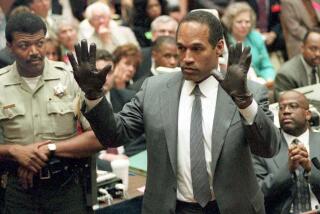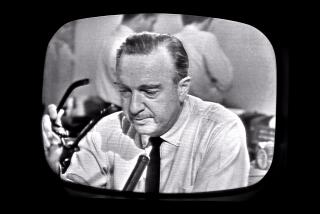Wall Street Fluctuates; Can TV News Keep Its Eyes on the Prize? : Television: Though the networks geared up for major developments on Wall Street on Monday, interpreting a wobbly marketâs meaning for the audience proved difficult.
Because the stock market had plummeted 190 points last Friday, possibly foreshadowing another calamitous day reminiscent of the 508-point crash on âBlack Mondayâ two years ago, CBSâ Dan Rather was up early Monday to anchor special live coverage of the activity on Wall Street.
At 7 a.m. PDT, half an hour into Mondayâs trading, Rather anchored a report that told of the marketâs early 65-point plunge. At 7:30 a.m., Rather was on the air again, this time declaring that the market had rallied and was now up some 25 points.
Then, as Rather was interviewing a Wall Street expert about the implications of such a turnaround, CBS cut back to reporter Richard Roth inside the exchange, who said the market had again plunged precipitously. A few minutes later, however, as part of the networkâs regular news show, âCBS This Morning,â Kathleen Sullivan corrected that negative news by saying there had been an error with the Wall Street computer, and the Dow Jones Industrial Average actually was still on the rise.
Computer foul-ups are just one of the difficulties that television news faces whenever it has to cover breaking news on Wall Street, an institution that doesnât lend itself to easy explanations or the sort of dramatic pictures that are a staple of TV news. Nonetheless, TV news organizations could not ignore the possibility of another dark day on Wall Street Monday and so put their star anchors on the air early with periodic summaries of the fluctuating events.
âCovering Wall Street is difficult because most of the people who routinely produce television news shows donât know enough about what things actually mean,â said Lane Venardos, director of special projects at CBS News. âIt requires a certain kind of knowledge and, in some cases, that knowledge may not exist even on the street. Experts often say right up front that they donât know what this drop means or what caused this increase, and we went out of our way to indicate that.â
âThe most important thing in covering any story is you want to be right, and in a rapidly fluctuating situation where the numbers are always changing, itâs tough to say this is the exact story at this moment,â said Lloyd Siegel, executive producer of special broadcasts at NBC, which used morning anchor John Palmer for its early special reports Monday because Tom Brokaw was on assignment in Los Angeles.
âThe other problem is making absolutely sure you project the correct tone so that you yourself donât become an actor. We want to give the audience information, but we donât want to panic them. People are out there making important decisions, and we donât want them to tune us in and see people jumping off ledges. So one of the most important challenges is being careful to always present a cool and steady, unsensationalized tone.â
CBS, NBC, ABC, Cable News Network, Headline News, Financial News Network and CNBC (Consumer News and Business Channel) all had correspondents and remote video trucks stationed at the New York Stock Exchange Monday. None of them is there on a normal day. In addition, all had live reports throughout the morning from the Tokyo and London exchanges; CNN also stationed a reporter live at the Chicago Board of Trade and updated the Dow Jones numbers every few minutes.
The stock market isnât a typically visual story, conceded CBSâs Venardos, who said that with the numbers changing constantly, his network instead relied on interviews to convey the meaning of the dayâs events.
Jeff Gralnick, executive producer of special broadcasts at ABC, which interrupted its regular programming with special reports from Peter Jennings throughout the day, downplayed the import of visuals.
âYou make the story out of what youâre given,â he said. âYou use a picture of the stock exchange just like you would use a picture of a plane crash. And ever since the explosion of devices that create graphics, visuals are not the problem. You have graphs, ratios, curves that show the range of trading throughout the day and can sum up exactly what is going on.â
âA day like this is one of those rare occasions where television business journalists do have excellent visuals and excellent sound,â said Lou Dobbs, anchor of CNNâs âMoneylineâ and managing editor of CNN business news. âThe picture of the floor of the exchange with all the traders scurrying about and the noise level building as it moved toward the opening are tremendous visuals and tremendous sound. That conveyed the anticipation and anxiety of the day better than any reporterâs words ever could.â
The various producers agreed that with the anticipation of a looming disaster, more average people without a fluency in the lingo of the financial world were looking to these news organizations for word of the dayâs events. With terms such as index arbitrage and circuit breaker flying off the lips of market experts, all producers instructed their reporters and interviewees to explain carefully all insider concepts in laymanâs terms.
As the day progressed and it became apparent that Monday would not end gloomily on Wall Street, TV news reports popped up with less frequency. Only Financial News Network and CNBC, which cover Wall Street in depth every day, stayed on the air with constant updates and analysis. Both preempted some of their regular programming to extend coverage of the worldâs markets. âWe thrive on this kind of day,â FNN producer Debbie Koehler explained. âEveryone was in early today, and everyone will stay late tonight. This is what we are here for. We are all in our element.â
More to Read
The biggest entertainment stories
Get our big stories about Hollywood, film, television, music, arts, culture and more right in your inbox as soon as they publish.
You may occasionally receive promotional content from the Los Angeles Times.










